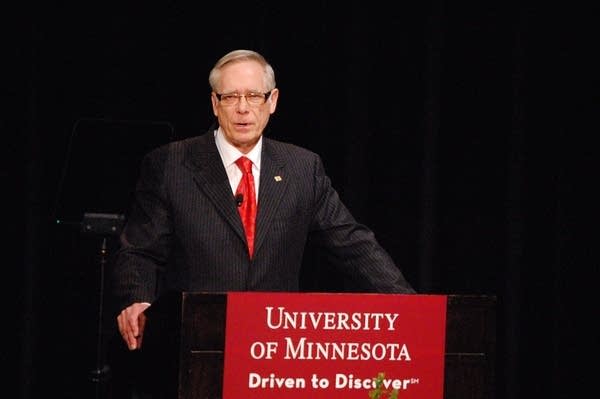MnSCU, U of M ponder what to pay their next leaders

There will soon be openings for the top jobs at the University of Minnesota and the Minnesota State Colleges and Universities system.
Some of the people doing the hiring say the starting salary they offer may be higher than what they're paying system leaders now.
If the university and MnSCU posted a help wanted ad for their next leaders, it might sound something like this:
Create a More Connected Minnesota
MPR News is your trusted resource for the news you need. With your support, MPR News brings accessible, courageous journalism and authentic conversation to everyone - free of paywalls and barriers. Your gift makes a difference.
Wanted: Chief executive officer for an organization that employs tens of thousands of workers and serves hundreds of thousands of customers. Experience in education, fundraising, labor negotiations and public relations required. Knowledge of multi-billion dollar budgets a plus. Compensation package ... negotiable."
In an age when public university presidents, on average, pull down close to a half-a-million dollars a year, the University of Minnesota and MnSCU are figuring out what they'll need to put on the negotiating table.
University of Minnesota President Robert Bruininks ranks as one of the highest-paid public college presidents in the U.S.
His base salary is $455,000 a year. Add retirement funds to the mix, and the total compensation package is almost $650,000.
The university also allows Bruininks to crash on its couch, so to speak. He lives at the university's official residence, Eastcliff, a stately, 20-room, 10,000-square-foot mansion on the banks of the Mississippi River.
But is all that enough to attract a top candidate to become the school's next leader?
Clyde Allen, chair of the university's Board of Regents, isn't sure. He says it could take more.
That could be controversial when the state faces a multi-billion-dollar budget deficit and student tuition continues to rise.
But, Allen says, any boost in salary would amount to a tiny percentage of the university's annual budget of more than a $3.4 billion.
"If you want just the right person who's going to get the most out of what we do spend on the university, that may be a very, very good investment," he said.
Officials at MnSCU are also trying to figure out how much to invest in their next leader.
Chancellor James McCormick receives a base salary of $360,000. With performance bonuses, retirement, and housing and car allowances, his total compensation is more than $450,000 a year.
Unlike the University of Minnesota, which decides on its own how much to pay its president, lawmakers determine the MnSCU chancellor's salary.
Lori Lamb, vice chancellor of human resources at MnSCU, says that was last set in 2009.
"The top of the range is $390,000 and there are additional compensation elements allowed in the personnel plan," Lamb says.
An additional $117,000 could be added to the base salary, through retirement and bonuses, meaning MnSCU could offer their next chancellor total compensation up to $507,000 a year.
That's $20,000 less than the average salary that systems similar to MnSCU pay their leaders.
If MnSCU wants to offer more to their next chancellor, they'll need to go to the Legislature next session and ask permission to offer a raise.
The first stop would be the legislature's joint committee on employee relations.
One of the commission's members last session, Republican state Sen. Gen Olson, of Minnetrista, isn't sure now is the time for such a request.
"Just because somebody else, some other system or some other state is doing it -- I think we have to consider Minnesota and what Minnesotans want too," she says.
Olson says if MnSCU and the U of M want to increase the already healthy salaries of their presidents, they also need to convince taxpayers it's necessary.
Saranna Thornton is an economics professor in Virginia. She also chairs a committee for the American Association of University Professors that monitors the economic status of the higher education profession.
She says pumping up the pay for a new president could be a tough sell to faculty and staff on MnSCU and U of M campuses since they've seen relatively small pay increases in recent years.
"There starts to be morale issues when compensation for presidents is increasing dramatically and compensation for faculty is remaining relatively flat."
Thornton says incoming presidents may have a hard time leading by example if they negotiate big salaries, and then need to make budget cuts or reduce the salaries of faculty and staff.
There are several examples of college presidents across the nation who have refused bonuses or voluntarily taken pay cuts over the last year.
University President Robert Bruininks is one of them. Bruininks pledged to donate any salary increases he received since 2002 back to the university, which officials say has totaled more than $200,000 to date.
